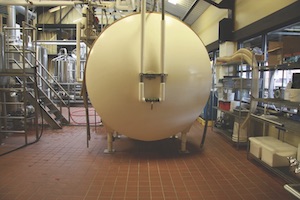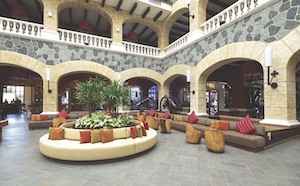Healthy building outlook for 2021 and beyond
Green building principles are rooted in environmental sustainability, and more recently in human wellness. Designers and specifiers are now increasingly focused on building product contents and their impact on human health. As a result, today’s green building market not only requires environmental performance and transparency, but also transparency pertaining to product ingredients. To satisfy green and healthy building market demands and facilitate product conformance to rating programs, codes, regulations, and purchasing requirements, the Tile Council of North America (TCNA) and its members have undertaken the following important initiatives over the past decade: Green Squared® standardization and certification, industry-wide Environmental Product Declarations (EPDs), and the Material Ingredient Guide.
Green Squared
Established nearly a decade ago as the world’s first standard and certification program for sustainable tiles and tile installation materials, Green Squared continues to serve as an important specification tool for the sustainability performance of products. With lifecycle-based multi-attribute sustainability criteria for product characteristics, manufacturing, end of life, corporate governance, and innovation, the standard ANSI A138.1 on which Green Squared is based is regularly referenced by green building codes and rating programs and by sustainable procurement officials.

A tile or related installation product that bears the Green Squared Certified® mark on its packaging or literature has been independently verified by one of two approved certification bodies, UL Environment or SCS Global, to meet ANSI A138.1. A listing of products that have been Green Squared Certified is available at GreenSquaredCertified.com, and this database of information is syndicated with other databases that list products eligible for green building contribution. These include purchasing portals developed by the GSA for federal purchasers, libraries of sustainable products developed for public universities’ procurement departments, catalogs of green building products approved by several A&D firms, and the Sustainable Purchasing Leadership Council’s product search engine. Furthermore, UL Environment and SCS Global each list Green Squared Certified tiles and related installation materials in their product databases, which are syndicated with a host of additional databases throughout the design community.
EPDs


Product transparency has become increasingly important to green building specifiers and designers. Regarding environmental transparency, there is a growing need for quantitative reporting of the impacts of products so that the environmental “footprint” of buildings can be calculated. An EPD is a vehicle for reporting product environmental data in a standardized manner. Just as nutrition labels inform the calorie conscious on food choices, an EPD reports the most important environmental considerations, based on an environmental life cycle assessment (LCA), in a common framework to end users.
TCNA and its members developed industry-wide EPDs for ceramic tile, mortar, and grout made in North America. These EPDs provide a comprehensive overview of how these products, on average per installed square meter, impact the environment over an estimated building service life of 75 years. To produce each of these EPDs, participating manufacturers provided extensive data on their materials and operations and participated in a cradle-to-grave evaluation of their products, from raw material sourcing/extraction, through manufacturing, delivery, installation, use, and end of life. When comparing EPDs for tile and related products alongside other flooring products’ generic EPDs, including LVT, LVP and several other plastic-based flooring materials, one thing is clear: Overall, ceramic tile has the lowest 75-year environmental impact per square meter. Each EPD has been independently verified by UL Environment, and participating manufacturers can reference the EPDs when such information is required by green building specifiers and procurement officials.
Material Ingredient Guide


Regarding health and wellness transparency, building product suppliers are increasingly required to disclose the content of their products using standardized product material ingredient reporting formats. According to the Healthy Building Network, consumers have the “right to know,” and it is “the responsibility of the manufacturer” to provide “transparency” in product material ingredient reporting. There are many green and healthy building industry-recognized material ingredient reporting formats, each of which requires the disclosure of chemicals within a product above a specified threshold and associated toxicological screening and assessment results.
To facilitate tile, mortar, and grout manufacturer conformance to product material ingredient reporting criteria, TCNA and its members worked with WAP Sustainability to develop an industry Material Ingredient Guide. This guide, a first of its kind by any building product industry, provides strategic instructions for manufacturers to follow when providing the content and chemical makeup of their products using recommended Health Product Declaration (HPD) or Manufacturer Inventory (MI) material ingredient reporting formats. Additionally, the guide provides information about the material ingredients most commonly used by North American manufacturers, references in-depth chemical assessments of the materials, and provides insights into the industry’s role in satisfying healthy building criteria. In developing this guide, 17 manufacturers collaborated on the largest crowdfunded collection of GreenScreen Assessments® to obtain GreenScreen® Benchmark Scores for the vast majority of material ingredients used by ceramic tile, mortar, and grout manufacturers. TCNA members who participated in this effort have a unique opportunity to use the guide’s referenced GreenScreen Assessments® in their material ingredient reports, pursuant toward contribution to green and healthy building “optimization” credits.
Find it here: https://whytile.com/guide/resource-library/.
Satisfying market demands, achieving green and healthy building conformance
With Green Squared, industry-wide EPDs, and the Material Ingredient Guide, the North American tile industry has a complete kit of resources toward the specification and promotion of its products for green and healthy building initiatives. These resources help products contribute credits toward LEED, Green Globes, and NAHB National Green Building projects, facilitate compliance to International Green Construction Code, ASHRAE 189.1 and GSA P100 federal facility criteria, and engender confidence from private and public sector green and healthy building product purchasers.


For LEED building projects, Green Squared Certified products contribute toward the “Certified Multi-attribute Products and Materials” credit. Products covered by the industry-wide EPDs contribute to the “Building Product Disclosure and Optimization – Environmental Product Declaration” credit.
Products following steps toward material ingredient transparency per TCNA’s Material Ingredient Guide contribute toward the “Material Ingredient Reporting” credit. In fact, products with HPDs or MIs that reference the Guide’s GreenScreen Benchmark scores for pertinent chemicals contribute toward LEED’s “Material Ingredient Optimization” credit, a feat rarely achieved by other building products. With TCNA’s Material Ingredient Guide, it is anticipated that the North American tile industry will become responsible for the largest number of “optimization” eligible product ingredient reports in the market.
Building projects seeking Green Globes and NAHB National Green Building certification are also afforded a unique opportunity to be awarded points using tiles and related installation materials. Green Globes Section 10.2.1 awards points for the use of products that are Green Squared Certified and/or covered by the industry-wide EPD. NAHB’s National Green Building Standard, section 612.2, awards points for the use of Green Squared Certified products. Section 611.4 awards points for the use of products covered by the industry-wide EPDs, and section 610 awards points if environmental impacts presented in the EPD are lower than those of competitive products over at least a 60-year period.
It is also important to consider green building code and regulatory compliance. The International Green Construction Code, section 901.4.1.4.3, and ASHRAE 189.1, section 9.4.1.4.3, each require that at least 10 products installed in a building have an EPD and/or a third-party multi-attribute sustainability certification. GSA P100 Facilities Standards tiling provisions also have similar criteria. Using Green Squared Certified products and/or products covered by TCNA’s industry-wide EPDs contribute toward thresholds for compliance.
Finally, the use of Green Squared Certified tiles and installation materials, products covered by TCNA’s industry-wide EPD, and products with ingredient reports following TCNA’s Material Ingredient Guide engender confidence throughout the supply chain. Private and public sector procurement specifications are increasingly including health and environmental performance and transparency criteria. In fact, specifically pertaining to the public sector, the US EPA released Recommendations of Specifications, Standards, and Ecolabels for Federal Purchasing, citing many tile industry initiatives, including Green Squared.
Certainly, today, the current administration’s views on climate change and energy are clear, meaning a more intense spotlight on sustainability in general. It can be anticipated that increased EPA representation in standardization and the federal government’s desire to leverage building and construction procurement to the “highest environmental standards possible” will have an impact on green and healthy building demands throughout the entire market. With Green Squared certification for sustainability performance, industry-wide EPDs for environmental transparency, and the Material Ingredient Guide for health and wellness transparency, TCNA and the tile industry are well-positioned for green and healthy building for the remainder of 2021 and beyond.


Bill Griese
Griese is a LEED Accredited Professional (LEED AP) with a specialty in building design and construction. The chief visionary behind TCNA’s environmental efforts, Mr. Griese manages TCNA’s Green Initiative Committee. He is responsible for the development of Green Squared® – the first and only standard and certification program for sustainable tiles and tile installation materials – and industry-wide Environmental Product Declarations (EPDs) for North American-made ceramic tile, tile mortar, and tile grout.
He earned a Bachelor of Science degree in Ceramic and Materials Engineering from Clemson University in Clemson, SC.







